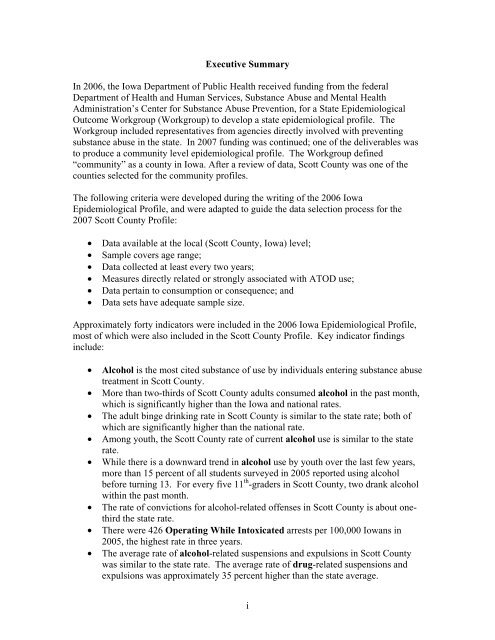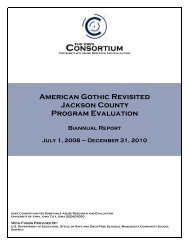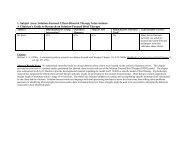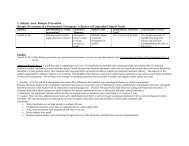Scott County Substance Use Epidemiological Profile 2008 - Iowa ...
Scott County Substance Use Epidemiological Profile 2008 - Iowa ...
Scott County Substance Use Epidemiological Profile 2008 - Iowa ...
Create successful ePaper yourself
Turn your PDF publications into a flip-book with our unique Google optimized e-Paper software.
Executive Summary<br />
In 2006, the <strong>Iowa</strong> Department of Public Health received funding from the federal<br />
Department of Health and Human Services, <strong>Substance</strong> Abuse and Mental Health<br />
Administration’s Center for <strong>Substance</strong> Abuse Prevention, for a State <strong>Epidemiological</strong><br />
Outcome Workgroup (Workgroup) to develop a state epidemiological profile. The<br />
Workgroup included representatives from agencies directly involved with preventing<br />
substance abuse in the state. In 2007 funding was continued; one of the deliverables was<br />
to produce a community level epidemiological profile. The Workgroup defined<br />
“community” as a county in <strong>Iowa</strong>. After a review of data, <strong>Scott</strong> <strong>County</strong> was one of the<br />
counties selected for the community profiles.<br />
The following criteria were developed during the writing of the 2006 <strong>Iowa</strong><br />
<strong>Epidemiological</strong> <strong>Profile</strong>, and were adapted to guide the data selection process for the<br />
2007 <strong>Scott</strong> <strong>County</strong> <strong>Profile</strong>:<br />
• Data available at the local (<strong>Scott</strong> <strong>County</strong>, <strong>Iowa</strong>) level;<br />
• Sample covers age range;<br />
• Data collected at least every two years;<br />
• Measures directly related or strongly associated with ATOD use;<br />
• Data pertain to consumption or consequence; and<br />
• Data sets have adequate sample size.<br />
Approximately forty indicators were included in the 2006 <strong>Iowa</strong> <strong>Epidemiological</strong> <strong>Profile</strong>,<br />
most of which were also included in the <strong>Scott</strong> <strong>County</strong> <strong>Profile</strong>. Key indicator findings<br />
include:<br />
• Alcohol is the most cited substance of use by individuals entering substance abuse<br />
treatment in <strong>Scott</strong> <strong>County</strong>.<br />
• More than two-thirds of <strong>Scott</strong> <strong>County</strong> adults consumed alcohol in the past month,<br />
which is significantly higher than the <strong>Iowa</strong> and national rates.<br />
• The adult binge drinking rate in <strong>Scott</strong> <strong>County</strong> is similar to the state rate; both of<br />
which are significantly higher than the national rate.<br />
• Among youth, the <strong>Scott</strong> <strong>County</strong> rate of current alcohol use is similar to the state<br />
rate.<br />
• While there is a downward trend in alcohol use by youth over the last few years,<br />
more than 15 percent of all students surveyed in 2005 reported using alcohol<br />
before turning 13. For every five 11 th -graders in <strong>Scott</strong> <strong>County</strong>, two drank alcohol<br />
within the past month.<br />
• The rate of convictions for alcohol-related offenses in <strong>Scott</strong> <strong>County</strong> is about onethird<br />
the state rate.<br />
• There were 426 Operating While Intoxicated arrests per 100,000 <strong>Iowa</strong>ns in<br />
2005, the highest rate in three years.<br />
• The average rate of alcohol-related suspensions and expulsions in <strong>Scott</strong> <strong>County</strong><br />
was similar to the state rate. The average rate of drug-related suspensions and<br />
expulsions was approximately 35 percent higher than the state average.<br />
i






